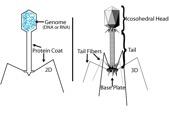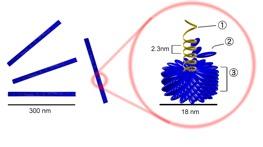Today, you will learn all about viruses by visiting various stations around the classroom while using a worksheet to guide you. For each question, go
Today, you will learn all about viruses by visiting various stations around the classroom while using a worksheet to guide you. For each question, go to the assigned website/read the article/watch the video and use the information to help you fill in the worksheet.
1. The Basics of a Virus - "What is a Virus? What is a Viral Infection?"
Article from: http://www.medicalnewstoday.com/articles/158179.php
a) What is the definition of a virus?
b) Where does this term come from?
Some microbiologists classify viruses as microorganisms, while others don't because they are "nonliving" and describe viruses as microscopic infective agents.
c) The diagram below illustrates one type of virus (influenza). State the three general components of a virus and describe it's function.

- Protein Coat (called the capsid, this protects the genetic information)
-Genetic Material (Either DNA or RNA)
-DNA
-Envelope (sometimes present around the protein coat when the virus is outside of the cell)
d) How can and do viruses spread (list four ways)?
.
2. Characteristics of a Virus - "What are the Essential Characteristics of Viruses?"
Article from: http://www.preservearticles.com/201101092882/characteristics-of-viruses.html
- List three non-living characteristics of a virus.
b) List four living characteristics of a virus.
c) Based on the above characteristics, do you think viruses are living or non-living entities?
3. Virus Morphology - "Four Shapes"
Article from: http://www.newworldencyclopedia.org/entry/Virus
Shape of Virus | Diagram of Virus | Example of Virus |
Bacteriophage
|  |
These viruses possess a capsid that is neither purely helical, nor purely icosahedral, and may possess extra structures such as protein tails or a complex outer wall. Bacteriophages have a complex structure consisting of an icosahedral head bound to a helical tail via a protein collar, and a hexagonal base plate with many protein tail fibers protruding from it.
|
Icosahedral virus
|
| Icosahedral capsid symmetry results in a spherical appearance of viruses at low magnification, but consists of capsomers arranged in a regular geometrical pattern, much like a soccer ball, hence they are not truly "spherical." |
Helical Ebola virus
Image transcription text S
|
|
Helical capsids are composed of a single type of protomer stacked around a central circumference to form an enclosed tube resembling a spiral staircase. This arrangement results in rod-shaped virions that can be short and rigid, or long and flexible. |
Marburg virus
|
|
The Marburg virus attracted widespread press attention for an outbreak in Angola. Beginning in October 2004 and continuing into 2005, the outbreak was the world's worst epidemic of any kind of hemorrhagic fever.
|
4. Virus Reproduction: Basic reproduction (virus without envelope), The Lytic Cycle (for bacteriophages) & The Lysogenic Cycle

4a. Virus Reproduction: BASIC REPRODUCTION
The diagram on the before this shows the simplest viral reproductive cycle of a virus. This occurs in viruses that do not have an envelope. Use the following letters and descriptions to label the diagram.
- Host enzymes transcribe the viral genome into viral mRNA, which other hosts enzymes use to make more viral proteins.
- Virus enters cell and is uncoated, releasing viral DNA and capsid proteins.
- Host ribosomes translate viral mRNA into capsid proteins.
- Viral genomes and capsid proteins self-assemble into new virus particles, which exit the cell.
- Host enzymes replicate the viral genome.
4b. Virus Reproduction: LYTIC CYCLE
Website: http://www.youtube.com/watch?v=wVkCyU5aeeU
The Lytic Cycle is a viral reproductive cycle, during which a virus takes over all metabolic activities of a cell and causes the host cell to die. Bacteriophages that ONLY reproduce using the lytic cycle are called a virulent phages.
As you watch the video, write down the name of each stage, and describe what is happening in each stage in point form.

Stage of Lytic Cycle | Description of Stage of Lytic Cycle - What is happening? |
| To infect a cell, a virus must first enter the cell through the plasma membrane and (if present) the cell wall. Viruses do so by either attaching to a receptor on the cell's surface or by simple mechanical force. The virus then releases its genetic material (either single- or double-stranded RNA or DNA) into the cell. In doing this, the cell is infected and can also be targeted by the immune system. |
| The virus' nucleic acid uses the host cell's machinery to make large amounts of viral components. In the case of DNA viruses, the DNA transcribe itself into messenger RNA (mRNA) molecules that are then used to direct the cell's ribosomes. One of the first polypeptides to be translated destroys the host's DNA. In retroviruses (which inject an RNA strand), a unique enzyme called reverse transcriptase transcribes the viral RNA into DNA, which is then transcribed again into RNA. Once the viral DNA has taken control it induces the host cell's machinery to synthesize viral DNA, protein and starts multiplying. About 25 minutes after initial infection, approximately 200 new bacteriophages are formed and the bacterial cell bursts i.e. it has undergone lysis. Newly formed phages are released to infect other bacteria and another lytic cycle begins. The phage which causes lysis of the host is called a lytic or virulent phage. The biosynthesis is (e.g. T4) regulated in three phases of mRNA production followed by a phase of protein production. |
| There are three classes of genes in the phage genome that regulate whether the lytic or lysogenic cycles will emerge. The first are the immediate early genes, the second is the delayed early genes and the third is the late genes. 1. Immediate early genes: These genes code for two transcription factors: N and cro. N is an anti-termination factor that is needed for the transcription of the delayed early genes. cro has two functions. The first function is to repress the activity of the repressor that is needed to go into lysogeny. Note that a repressor coded by the CI gene is needed to repress the lytic cycle from taking place. The second function of cro is to initiate the transcription of the late genes needed for the lytic cycle to go to completion. 2. Delayed early genes: The immediate early gene N is required to express the delayed early genes. In lytic cells, the delayed early gene which is most important is Q. These genes are also used to express late genes. 3. The repressor: The repressor is needed to repress the lytic cycle for lysogeny to proceed. It has 2 N domains that bind the DNA via a helix turn helix motif and 2 C domains that dimerize to stabilize the protein. 4. Lysis inhibition: T4-like phages contain a gene called rI which can delay completed phage progeny from exiting an impregnated cell by suppressing the expression of holin gene products usually up to four hours in exponential phase growing cultures in rich media. Deletion of rI cancels the inhibition effect. This is only observed when higher concentrations of extracellular T4 phage particles are present.
|
| After many copies of viral components are made, they are assembled into complete viruses. |
| The phage then directs production of lysin, an enzyme that breaks down the bacterial cell wall, which allows extracellular fluid to enter the cell. The cell eventually becomes filled with viruses (typically 100-200) and liquid, and bursts, or lyses; thus giving the lytic cycle its name. The new viruses are then free to infect other cells. |
4c. Virus Reproduction: LYSOGENIC CYCLE
Watch: http://www.youtube.com/watch?v=wLoslN6d3Ec and Textbook Printout
The Lysogenic Cycle is another type of viral reproductive cycle in which the genome of the phage is replicated without destroying the host. Phages capable of using both modes of reproduction (lytic and lysogenic) are referred to as temperate phages.

a) During the lysogenic cycle, the phage genome is mostly silent within the bacteria. Why?
b) What determines whether or not the lytic cycle or lysogenic cycle is entered?
5. The Immune System of Bacteria - Why haven't phages exterminated all bacteria?
Article from: http://www.scq.ubc.ca/restriction-endonucleases-molecular-scissors-for-specifically-cutting-dna/
- What are restriction endonucleases (restriction enzymes) and what do they do?
- List two reasons why phages haven't exterminated all bacteria despite the fact that they are capable of reproducing using the lytic cycle.
6. Viral Infections - "What is a Viral Infection?"
Article from: http://www.medicalnewstoday.com/articles/158179.php
Viruses are very specific. That is, they only infect a very limited range of species and target certain organs and cells. These specific species/organs/cells are referred to the virus' host range. Using the information found on this website, fill in the following chart for the given viruses.
Name of Virus | Organism, Tissue, Organ, or System Affected | How it Affects the Organism, Tissue, Organ or System |
Measles
|
Measles is an endemic disease; meaning it is continually present in a community and many people develop resistance. If measles enters an area where the people have never been exposed the result can be devastating.
| By infested with tapeworms. |
Shingles
|
Nervous system
| The patient will generally feel a tingling sensation in the affected area at first. This will be followed by pain, and then a rash. |
SARS
|
Respiratory system
| Constricts the respiratory system. |
7. Case Study - HIV/AIDS (for homework - do your own research!)
- Label the following parts of the HIV virus.

esophageti
meningitis
pneumonia
![]()
tubercolosis
a) Why is HIV called a retrovirus?
b) Fill in the following chart using point form notes.
History of HIV
Both HIV-1 and HIV-2 are believed to have originated in non-human primates in West-central Africa and to have transferred to humans (a process known a zoonosis) in the early 20th century. HIV-1 appears to have originated in southern Cameroon through the evolution of SIV(cpz), a simian immunodeficiency virus (SIV) that infects wild chimpanzees(HIV-1 descends from the SIVcpz endemic in the chimpanzee subspecies Pan troglodytes troglodytes).The closest relative of HIV-2 is SIV (smm), a virus of the sooty mangabey (Cercocebus atys atys), an old world monkey living in litoral West Africa (from southern Senegal to western Côte d'Ivoire). New World monkeys such as the owl monkey are resistant to HIV-1 infection, possibly because of a genomic fusion of two viral resistance genes. HIV-1 is thought to have jumped the species barrier on at least three separate occasions, giving rise to the three groups of the virus, M, N, and O.
| Transmission of the HIV Virus and Prevention
Sexual transmission. It can happen when there is contact with infected sexual secretions (rectal, genital or oral mucous membranes). This can happen while having unprotected sex, including vaginal, oral and anal sex or sharing sex toys with someone infected with HIV. Perinatal transmission. The mother can pass the infection on to her child during childbirth, pregnancy, and also through breastfeeding. Blood transmission. The risk of transmitting HIV through blood transfusion is nowadays extremely low in developed countries, thanks to meticulous screening and precautions
|
Treatment of HIV/AIDS
Emergency HIV pills. If an individual believes they have been exposed to the virus within the last 72 hours (three days), anti-HIV medication, called PEP (post-exposure prophylaxis) may stop infection. Antiretroviral drugs. HIV is treated with antiretrovirals (ARVs). The treatment fights the HIV infection and slows down the spread of the virus in the body.
| System/Cell Affected and How
This may affect the eyes,the lung and by tumors, esophagitis, tubercolosis, retinitis.
|
Source:
Step by Step Solution
There are 3 Steps involved in it
Step: 1

See step-by-step solutions with expert insights and AI powered tools for academic success
Step: 2

Step: 3

Ace Your Homework with AI
Get the answers you need in no time with our AI-driven, step-by-step assistance
Get Started









